


Winning starts with what you know
The new version 18 offers completely new possibilities for chess training and analysis: playing style analysis, search for strategic themes, access to 6 billion Lichess games, player preparation by matching Lichess games, download Chess.com games with built-in API, built-in cloud engine and much more.
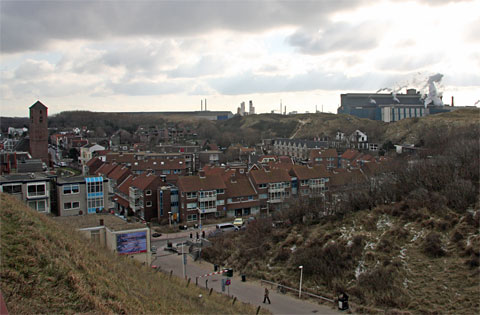
The city of Wijk aan Zee, with the Corus steel factory in the background
Our reports on the Super-GM tournament in Wijk aan Zee this year apparently struck a chord with our visitors. We got scores of letters commenting on them. Mind you, not all positive. There was this one reader with an Indian name who took offence at Steve Giddins' "ramblings", and another from Malta, who wrote in the same vein. But this was neutralised by dozens of positive messages. For instance Rajko Vujatovic from London wrote, quite typically: "I very much enjoyed Steve Giddins' reports from Wijk! Excellent balance of humour, storytelling and chess instruction." Or one from Christer Persson (Tiger's father), which said: "I liked Steve Giddins presentation of round eight very much! It was both talent and hard work, much like the chess it describes!" And here's one letter that reminds us why we are doing it all:
Andrew Foote, Los Angeles, California
Your coverage of Wijk aan Zee 2009 was outstanding, "across the board":
news, reports, games, photos. With passion, humor, and superb chess reporting
(and equally superb and supportive website), you have scored many points with
me. And this is just one example, from one event, of many that I have enjoyed
lately at your site. Good job! Your story on Anish Giri making his final GM
norm had it all: great photos, captions (not a lost art after all!), story,
and games (plural). What a nice touch to include all Anish's games,
not just the expected one where he achieved his final GM norm! I'm sure that
when Anish saw this story he was as happy as when the lead photo of him was
taken. A real keeper, something he and his family will no doubt treasure.
Dr. John's shots of Anish and other GMs each told a story, creating a wonderful
"bounce flash" back and forth from photo to photo, and photo to
caption. And then, finishing up with a night shot of Andromeda – sweet!
Thanks again Frederic, Dr. John and others. Your talent and teamwork make
it all come together.
Well, with so many positive letters, and so many still unpublished pictures, we decided to introduce what we are going to call a "retrospect" (a noun form that is to our knowledge not normally used in this sense). It is an attempt to use material we have collected that it seems a shame to waste. Here then is our first retrospect: a revisiting of the 2009 Corus tournament in Wijk aan Zee.
This year in Wijk aan Zee we had the special pleasure of working with our friend and colleague Dr John Nunn. John is a grandmaster, mathematician, scientist and general all-round boffin, He runs a chess publishing house, but is also conveniently engaged in photography as a prime hobby. He came to the tournament on the final weekend, armed with his Canon 40D (while I was fussing around with my Lumix FZ50, which does have a much bigger zoom). Almost all of the pictures in this article were taken by John or with his Canon.
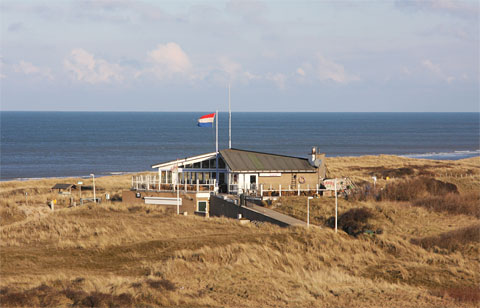
A view of the Wijk aan Zee beach from my hotel room balcony
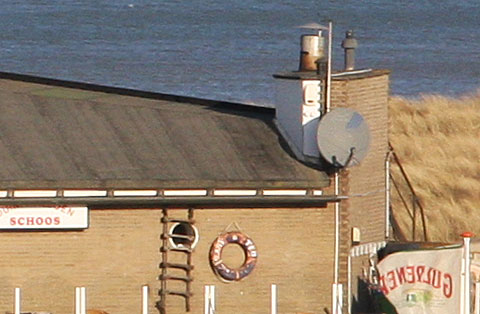
This beach picture was part of a lens test to compare John Nunn's Canon
40D with my Lumix FZ50.
The Canon won this one hands down: this segment in the original resolution resolves the bricks in the chimney of the first picture, and also allows you to read the sign and the flag. Impressive.
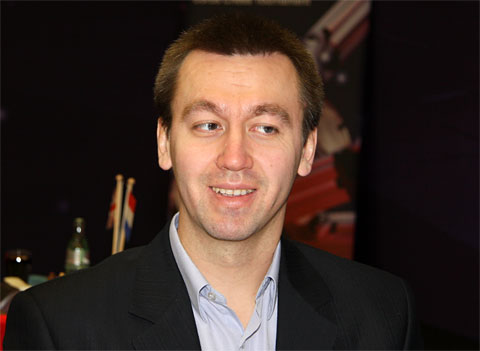
A rare smile: Gata Kamsky in a light-hearted mood before a game
Gata, who was a World Championship candidate in the nineties, abandoned competitive chess in order to study medicine (for one year) and then law. He graduated from Touro Law Center in New York, but then returned to chess in June 2004 and soon became the number one chess player in the US – instead of, oh, the number 25,000 lawyer in the New York area. Wise career move! Before his break from chess many considered Kamsky to be sullen and hostile. Since his comeback he is, as we can testify, utterly charming – outgoing, humourous, even affectionate. When you read this he will be on the verge of or already have started playing a candidates match against Veselin Topalov in Sofia, Bulgaria. It is probably not appropriate for us to say this, but: good luck, Gata!
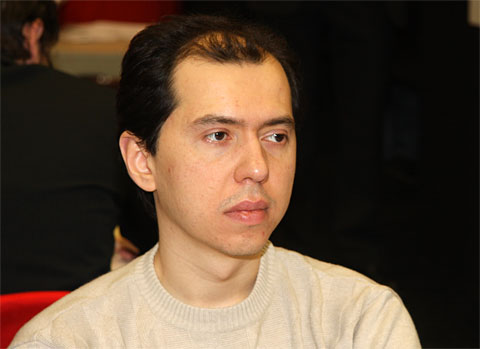
Rustam Kasimdzhanov, one of a triumvirate of overeducated Eastern European
GMs
The characterisation comes from my wife who, listening to Peter Svidler explain something in typically erudite words, said: "that guy is hopelessly overeducated!" Rustam, Peter and Levon Aronian are the three grandmasters hailing from the former Soviet Union who never cease to amaze with their knowledge of Western culture – literature, music, films, contemporary TV, philosophy, politics, you name it. All three have an exquisite sense of humor, and it is always a pleasure to be with them at chess events.

Israeli GM Maxime Rodshtein, who turned 20 in Wijk, was there to help Aronian
In 2004 Maxime won the World U-16 championship in Greece. In the meantime his rating has risen to 2650, making him the fourth highest ranked player in his country (after Gelfand, Sutovsky and Postny). He is also a major heartthrob in the international chess scene.
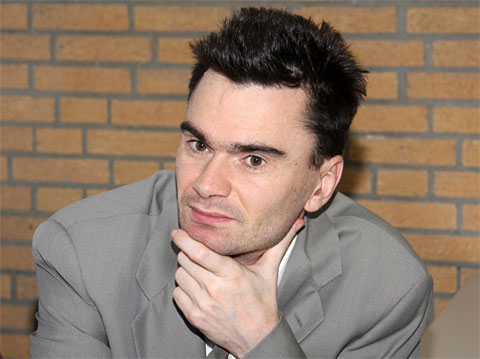
Loek van Wely, top Dutch grandmaster, who had a 2696 performance this year
in Wijk
"Top Dutch grandmaster?" we hear Sergey Tiviakov ask in surprise. He may indeed take exception to our caption, having himself won the Dutch championship in 2006 and 2007 and being located much higher than Loek on the FIDE rankings. But of course Sergey was born in Krasnodar, Russia, and is therefore a naturalised Dutch grandmaster, just like Ivan Sokolov, who hails from Bosnia and is also higher than van Wely on the Elo scale. So can we agree on the following: Loek is currently the strongest native son.

Oleg Romanishin, Ukrainian GM who got battered by the youth in the C-Group
I met Oleg Mikhailovich again, after many years, in Wijk. He was appalled when I addressed him in English. "But we always spoke German, didn't we" he said fluently. Romanishin, 57, was a world class player, finishing second in the 1975 USSR Championship (together with Tal and Petrosian), and adding an impressive list of tournament victories in the following years. In Wijk he was badly mauled by a bevy of young players who were not born when he had essentially ended his active career.
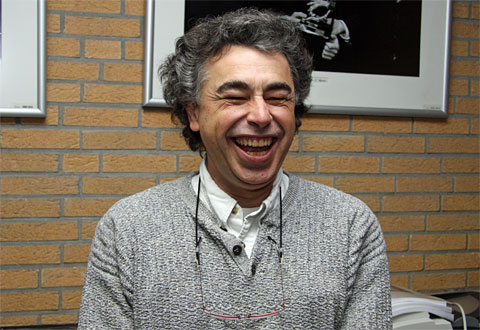
Another veteran: Yasser Seirawan, who will turn fifty next year
Oh my, how time flies. Yasser, whose name is actually ياسر سيروان, was born in Damascus to a Syrian father and an English mother. The family moved to Seattle when he was seven, where he spent most of his life (today he lives in Amsterdam). During his active career he was one of the world's best. Nowadays he entertains visitors on the Playchess server with his "honeyed voice" (Nigel Short) and his insightful, humorous commentary. In any case humour is the dominant factor in all interactions with Yasser. He will do little sketches or tell seriously funny stories at a second's notice. We have learnt a lot about the anecdotal presentation from this grandmaster, and done so over the last twenty years.

Yasser is married to Yvette Nagel, "een Nederlands schaakster en een
FIDE meester"
Yvette is the daughter of former Leefbaar Nederland political party president and politician Jan Nagel. She has played in and helped organise many events in Holland. In 1981 Yvette was girls champion of the Netherlands and in 1983 she represented her country at the World Cup in Mexico. Her current rating is just over 2000.
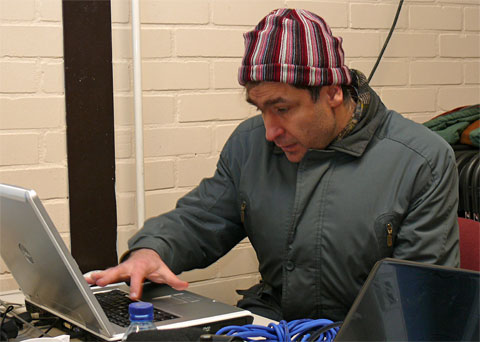
Straight to the Internet after a game – Vassily Ivanchuk in the press
room
Vassily is an intense person. One always has the feeling that there is so much going through his mind that it is rude and inappropriate to bother him with simple chit-chat. Last September I was sitting with my luggage in the hotel lobby in Bilbao, when Vassily came over to ask what I was doing. "Waiting for my airport pickup," I said. "How long must you wait?" he asked. "Two hours. I had to check out of my room at 12," I replied. "Okay," he said, and took a seat next to me, clearly with the intention of keeping me company. After ten minutes I couldn't resist and started a conversation – Vasil had apparently been willing to sit there without saying a word. It turned into an animated discussion – he is very interesting and entertaining, once he gets started.
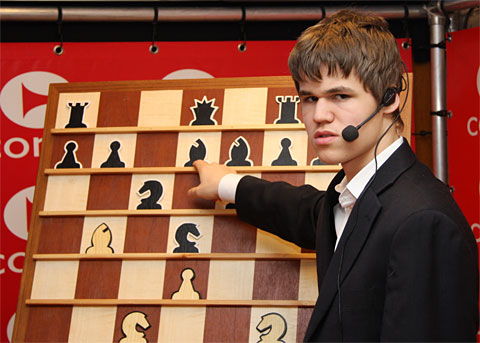
That bishop? Are you serious? Magnus Carlsen doing post-game analysis
One of big stars in Wijk was, of course, Sven Magnus Øen Carlsen. This eighteen-year-old clearly represents the future of chess. He is so well-known that biographical details here would bore you – except perhaps this one: for a few days, back in September last year, at the age of seventeen, he was number one in the world on the live rating list (which is unofficial and calculated on a daily basis), six points ahead of World Champion Vishy Anand. Right now Magnus is number three on the live ratings, and number four on the official FIDE world rankings. His main age-group rival is Sergey Karjakin, who celebrated a great triumph in this year's Wijk event.

Sergey Karjakin, the youngest grandmaster in the history of chess
Some readers accuse us of over-reporting the exploits of Magnus Carlsen while not appreciating the potential or the importance of young Sergey from Ukraine. Perhaps. I have known Sergey since he was 13 and visited me in Hamburg, together with his disconcertingly youthful mother Tatiana. We have been great friends ever since. In Wijk we tend to check, every year, whether he can beat me in arm wrestling. Sergey has worked with Nigel Short and was involved in a car accident with him in 2005. Tatiana believes in UFOs and is supported in this by Sergey Tiviakov, the top Dutch grandmaster mentioned above.
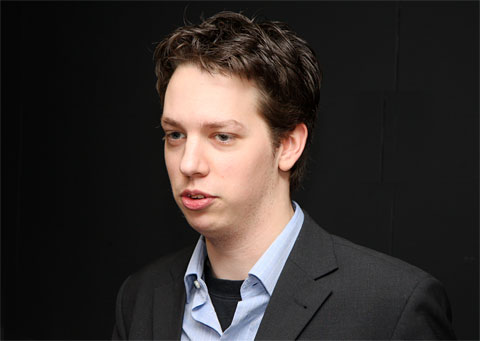
Daniël Stellwagen, who finished 12th in the A-Group, but earned some
Elo points
The 21-year-old Dutch grandmaster was a silver medalist at the U12 World and European Junior Championships. In 2004, at eighteen, he became the youngest Dutch grandmaster ever. Daniël is also an excellent problem solver and at sixteen won the endgame study solving contest at the De Feijter Festival in Deventer with an unprecedented 100%.
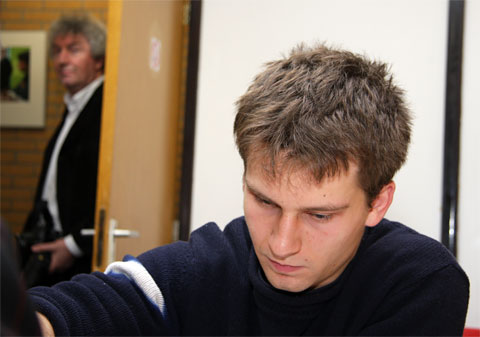
Andrei Volokitin, former U12 world champion from the Ukraine
I don't know Andrei too well, just that he was a grandmaster at the age of 15 and comes from Ukraine, where young GMs spring up like mushrooms after a rainy day. I include the picture above mainly because of the gentleman lurking in the background. It is Dutch photographer Fred Lucas in a typical pose: camera in his hand, looking for the perfect visual motive. Fred's pictures are famous enough and do not need further introduction. I have learnt a great deal about photography from him.
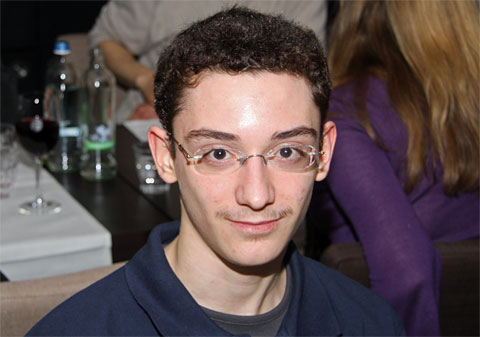
Fabulous Fabiano Caruana, the winner of the B-Group
In the final round Fabiano managed to eke out a victory against a tiring Nigel Short and win the very strong B-Group all by himself. This means that this Italo-American-Hungarian prodigy will play in the A-Group next year, when he will be just seventeen. But that does not mean too much these days. Remember that last year one Magnus Carlsen, seventeen years of age, actually won the A-Group (together with Levon Aronian). Maybe when Giri wins it in 2011 we will break into oohs and aahs again.

Alexander Chernin, chess grandmaster and prodigy trainer
Alexander Mikhailovich Chernin is 48 and originally from Ukraine. In 1979 he was second in the World Junior Championship, behind Yasser Seirawan, the laughing grandmaster we depicted above. In 1992 he moved to Budapest and a year later became a Hungarian national. Around the turn of the century, he became a chess trainer. Which is why the Italo-American GM in the previous picture lives in Hungary. Fabiano needs to be close to his coach.
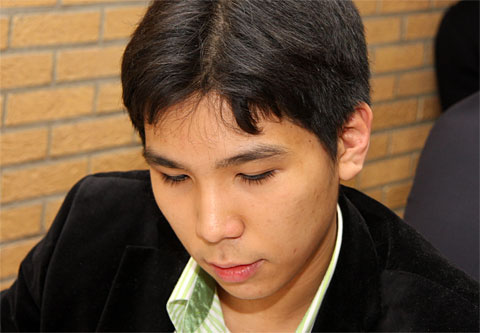
Wesley So, one of the world's youngest GMs, won the C-Group by a full point
Wesley, who is from the Philippines, is fifteen and certainly one of the biggest chess talents around. He achieved the GM title at the age of 14 years, 1 month and 28 days, which makes him the seventh youngest person to do so in the history of the game. Unfortunately Wesley's English is a bit shaky. It was interesting that at breakfast in the Hoge Duin hotel in Wijk my remarks to him would often have to be translated by Abhijeet Gupta – from English into English. Apparently Wesley understands Abaijeet's accent better than mine.
At the end of round twelve John Nunn and I encountered Levon Aronian, who had overpressed against Morozevich and had been lucky to survive.
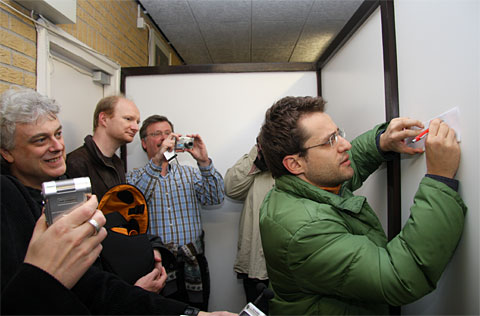
"I have a problem for you, John," said Levon, and proceeded to
write it down on a paper
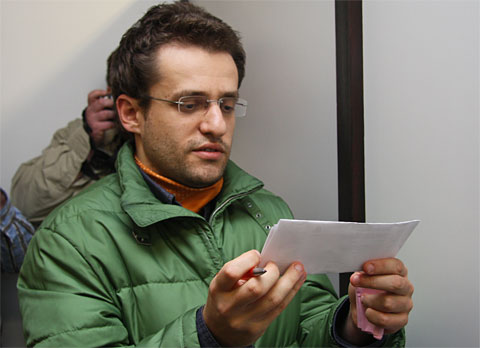
It's a three-mover by Vladimir Akopian, he told us, and "very hard
to solve."

In the press room John tackled the position, but had serious problems with
it

Anish Giri, the world's youngest grandmaster, also took a look at the problem
Anish is destined to scale the ultimate heights in chess. I say this after chatting with the kid, and after witnessing his reaction to Aronian's problem. "The position is not correct," he said, in about twenty seconds, standing three meters from the board. Why? Because there are many solutions, he said, rattling off a few. Sharp as a razor, this kid. John agreed that something was wrong, and in an Italian restaurant that evening confronted Levon. After a brief discussion Lev said: "Oh, sorry, there is a white pawn on e4" (don't you hate it when they do that?). After that we had the correct position.
Vladimir Akopian
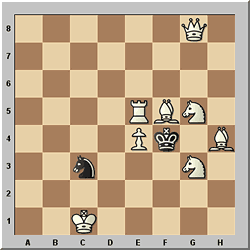
White to play and mate in three
Without the pawn on e4 there is in fact a mate in two: 1.Qc4+ Kxe5 2.Nf7#. But with the white pawn in place things are more difficult. Can you spot the only move that leads to mate in three? [Addendum: Aram Hajian of Yerevan, Armenia, a close friend of Vladimir Akopian and Levon Aronian, informs us that Vladimir mentioned to him that the correct position of the problem should have the white queen on f7 and not g8.]

Sorry, guys, there is a pawn on e4! An atomic
noogy, that's what Levon deserves...

WIM Arianne Caoili from Australia, girlfriend of Levon Aronian
Everyone knows the story of how the two met and became romantically involved – or more precisely: the Bermuda Party Incident in 2006. Arianne is a Australian chess player of Philippine extraction (as you can plainly see). She is not just a pretty face. Her highest rating, in 2002, was over 2300, but now she has embarked on serious academic studies. Her level of discourse is generally very high. I love to receive emails from her with lines like the following tossed in: "Regarding Woody Allen's 'Vicky Cristina Barcelona', I dont recommend you see it. As Woody gets older he indulges a little too much in the latte-sipping, liberal, intellectual-melancholic genre instead of doing what he used to do best: giving us a film about something we all think about but are too shy to say out loud."

Leinier Dominguez with his girlfriend Yisel Martinez
I had the following exchange with this young lady: "So where are you from, Yisel?" – "Cuba. Actually from the same village as Leinier." – "And what do you do? What is your profession?" – "I am an atomic physicist." – "You are a WHAT?" – "You know, Frederic: atom? Boom!" – "Yes, I know what an atomic or nuclear physicist is. But are you really one?" – "Sure, why not?" – "Okay, sorry to do this, but can you tell me what a Large Hadron Collider is?" – "You mean the LHC? Well, I actually worked at CERN..." There followed an intense exchange in which I told her about my fears that the LHC might be a deadly threat to humankind. "No, no, don't worry," she said. "On the one hand it is highly unlikely – practically impossible – that dangerous black holes will be produced, the kind that last longer than microseconds before they evaporate due to Hawking radiation. And secondly they will probably never get it to run. The whole machine is too complicated, it will keep failing until they give up." Yep, she is the real thing.
Later that evening I told a friend about this conversation. "Why didn't I know this?" he groaned. "They were sitting at the next table at the closing dinner and I did not join them! I could have spent hours discussing particle physics with her, and instead had an evening listening to missed chances in an Open Catalan."
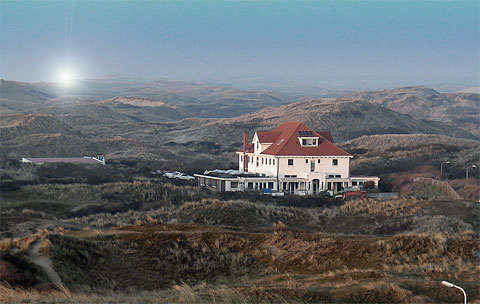
Emulating Lucas:
the final rays in Wijk aan Zee

And finally: our astronomical picture of the day by John Nunn [click to
enlarge]
This picture of the moon was made using a 10 inch Meade LX200 GPS telescope, last November. John took a series of pictures of different parts of the Moon and then stitched them together. The original image he sent us is roughly 6000 x 6000 pixels in size. We have a 1200 x 1066 version – impressive enough – which you can get by clicking the above image.